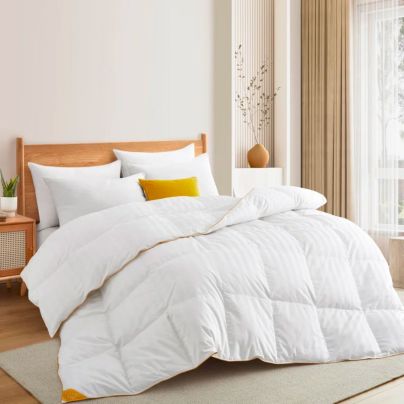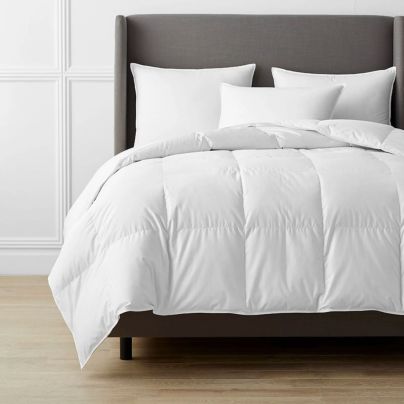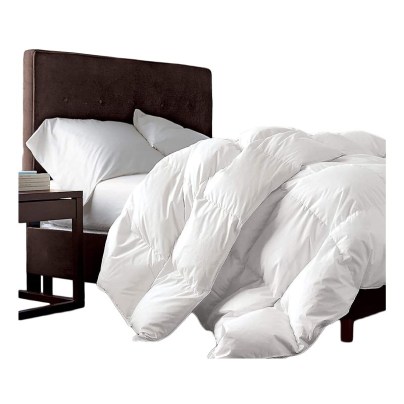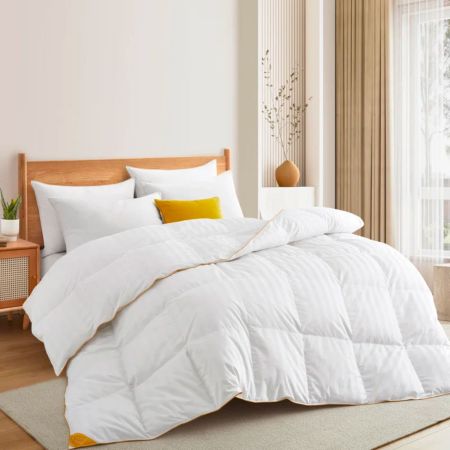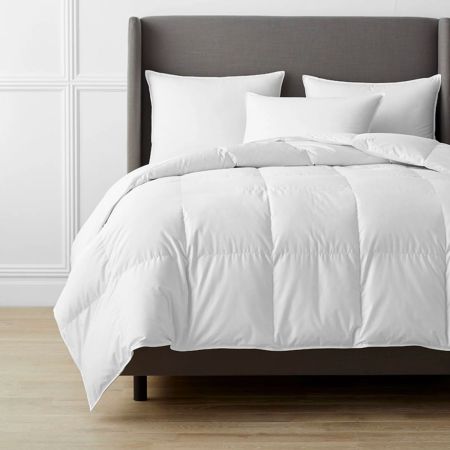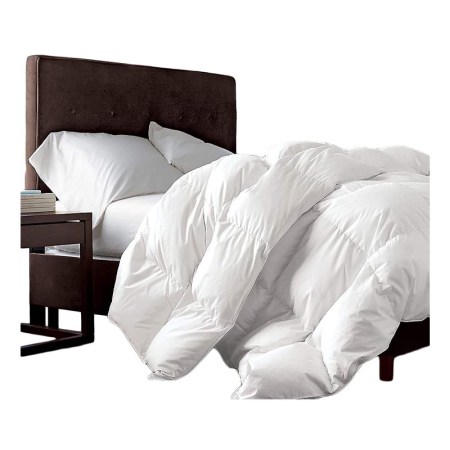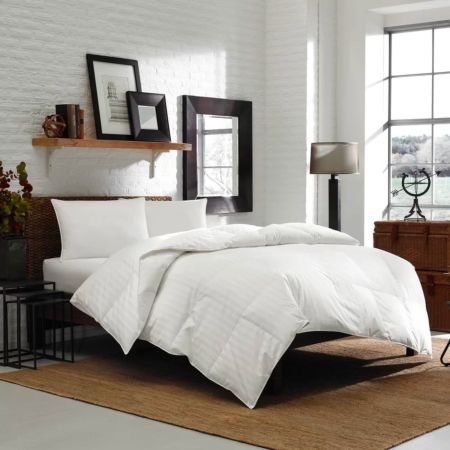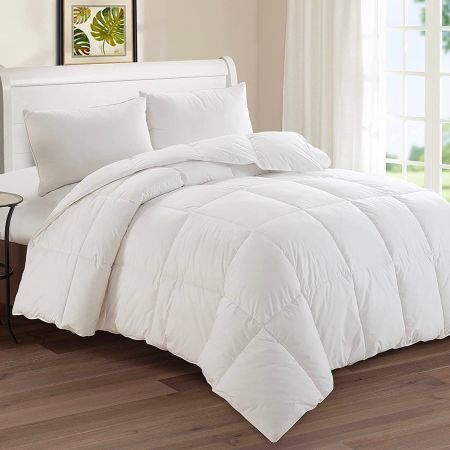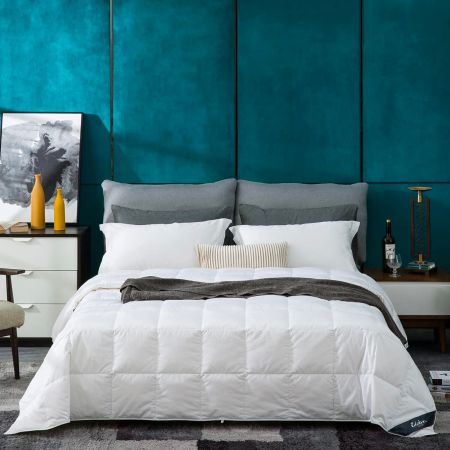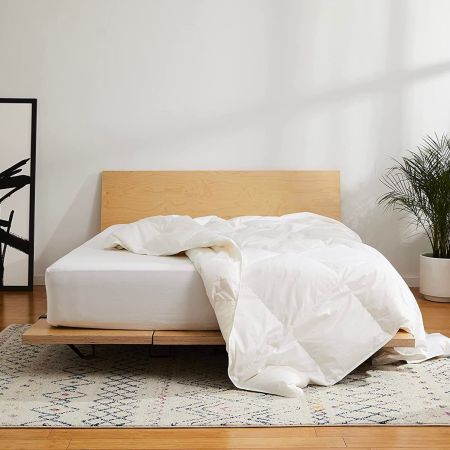We may earn revenue from the products available on this page and participate in affiliate programs. Learn More ›
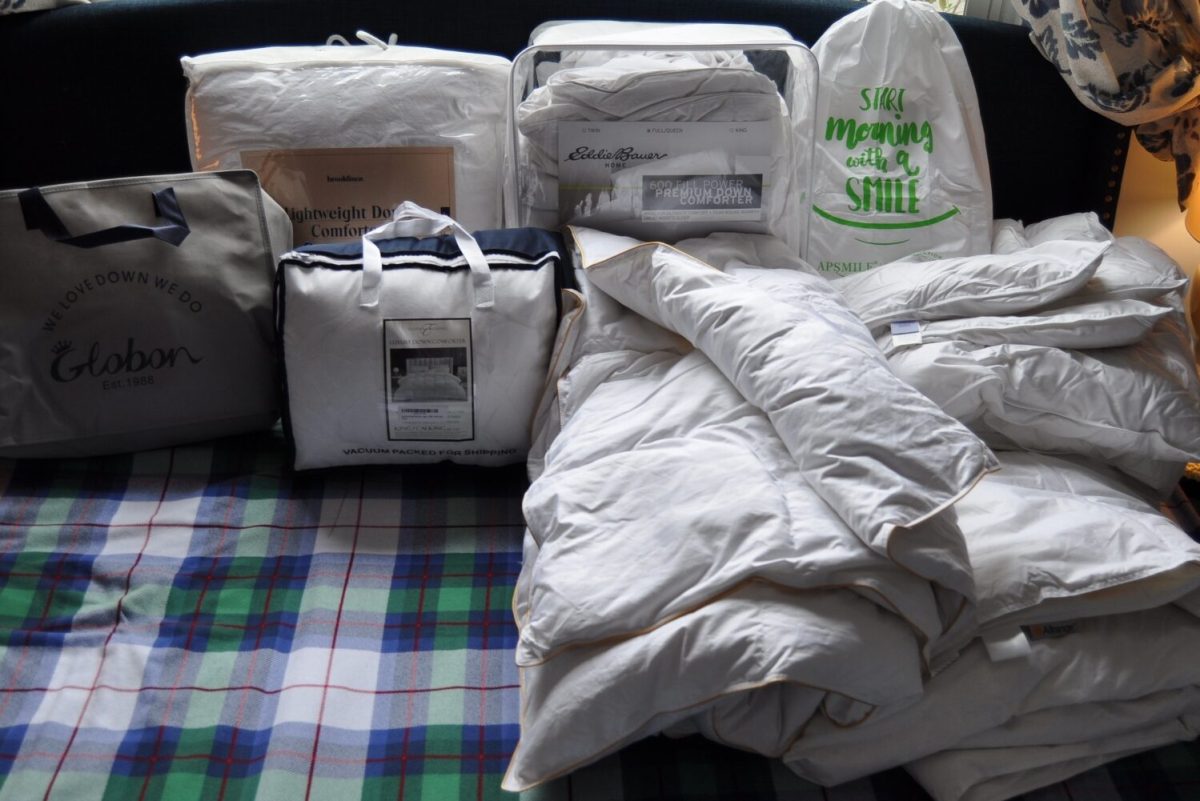
After a long and busy day, curling up with a fluffy comforter in bed can feel like a well-needed luxury. And in the world of bedding, down comforters are often considered to be the cream of the crop.
When it comes to choosing the best down comforter, prioritizing comfort, allergen health, and breathability are often essentials. The climate where you live and budget also play important roles in selecting the best down comforter. In order to help navigate the many down comforter options, we field-tested some of the most popular on the market.
Keep reading to find out the results of our hands-on testing, and learn about some of the most important factors to consider before jumping into this list of quality down comforters.
- BEST OVERALL: Alwyn Home All-Season Goose Down Comforter
- RUNNER-UP: The Company Store Legends Hotel Down Comforter
- BEST BANG FOR THE BUCK: Egyptian Bedding Siberian Goose Down Comforter
- UPGRADE PICK: Eddie Bauer All-Season Duck Down Comforter
- BEST HEAVYWEIGHT: Apsmile Luxury Siberian Organic Goose Down Comforter
- BEST LIGHTWEIGHT: Globon Texcote Summer Down Comforter
- ECO-FRIENDLY PICK: Brooklinen Down Comforter

How We Tested the Best Down Comforters
Testing down comforters was truly an enjoyable experience, especially since the testing occurred during a colder season. We looked at a variety of criteria (beyond the desire to stay cuddled up in bed for much longer than usual), including the thread count and softness, the construction and stitching, the fill power and weight that contributes to warmth, how well the comforter fit in the appropriate duvet cover, and how noisy or quiet the comforter was when shifting during the night. We also made note of feathers that might poke out of the comforter and other small but important points, such as the scent of the comforter right out of the box.
Our Top Picks
We field-tested some of the most popular down comforters available to help simplify the search and make it easier to choose the best down comforter for warm and cozy slumber. We kept the different types of comforters and features in mind during our testing in order to create our recommendations for down comforters in specific categories.
Best Overall
Alwyn Home All-Season Goose Down Comforter
See ItThis stylish white goose down comforter from Alwyn Home provides 24 ounces of down with a fill level of 600, making it ideal for layering on a bed in the winter or using it on its own in the summer. The 500 thread count and 100 percent cotton exterior provide incredible softness. The baffle-box stitching and piped edges provide sturdy construction and an attractive look, so it can be used without a duvet cover. However, the comforter does include ties/loops that allow it to be used with a cover without worry that it will shift over time.
Our testing found that this comforter doesn’t move much on the bed during the night, thus keeping the warmth right where it’s needed. It fits smoothly under a duvet cover and doesn’t offer as much loft as some other brands, which can be great if the intention is to layer the comforter with others of similar weight.
Product Specs
- Weight:51.6 ounces of goose down
- Thread count: 500
- Fill level: 600
Pros
- Ultrasoft exterior feels great on the skin for a soothing sleep
- Attractive side piping looks trendy even without a duvet cover
- Good for layering; helps provide a textured interest to the bedroom decor
Cons
- Doesn’t have much loft; may feel quite thin compared to other comforters
Get the Alwyn Home down comforter at Wayfair.
Runner-Up
The Company Store Legends Hotel Down Comforter
See ItThe 12-inch baffle-box construction of this 100 percent cotton down comforter from The Company Store helps ensure the 33 ounces of fill weight stay right where it should. The double-needle top-stitch keeps the pocket construction sturdy and strong, ensuring many nights of use for even the most restless sleepers.
At a slightly larger size than most other standard queen comforters, this one offers a generous 15-inch drop off the side of the bed. Our hands-on testing found the length to be a wonderful bonus, as it allows for truly cuddling up in the comforter on the coldest nights for soft comfort under the 300-thread-count material. Sleep assured that this comforter won’t aggravate allergies, as the six-step quality and purification process ensures the down is hypoallergenic.
Though a duvet cover can be used with this comforter, it’s quite attractive on its own. Plus, this comforter is machine washable, and if a duvet cover is desired, the anchor tabs keep it in place.
Product Specs
- Weight: 33 ounces of European down
- Thread count: 300
- Fill level: 600 to 650
Pros
- Available in 3 warmth levels depending on user preference: light, medium, or extra warm
- Sturdy construction with a comfortable and durable 300-thread-count cotton
- Generously sized compared to standard queen sizes; more room to share
Cons
- Not the best choice for very cold climates; other options provide more insulation
Get The Company Store down comforter at The Company Store.
Best Bang for the Buck
Egyptian Bedding Siberian Goose Down Comforter
See ItWhen seeking an all-around down comforter, many might look to the Egyptian Bedding Siberian goose down comforter. It’s filled with 58 ounces of premium goose down, which is an appropriate amount of fill for balanced warmth year-round. Encasing the filling is an all-natural Egyptian cotton cover with double-needle stitching and a super-soft 1,200 thread count. Its baffle-box construction helps the down stay fluffy and evenly dispersed even after heavy use.
This comforter’s natural down and cotton material ensure proper airflow and comfortable temperature regulation during sleep. Our testing found that the 750-fill power is more than enough for the coldest nights. Contrary to “whisper quiet” claims, we found this down comforter to be rather noisy when shifting underneath it. A duvet cover helped to remedy that problem.
If there’s a desire to attach a duvet cover to its eight corner loops to keep it clean, choosing a cotton option will help maintain the comforter’s natural breathability. Every component of Egyptian Bedding’s down comforter is stamped with the approval of the Responsible Down Standard (RDS) and OEKO-Tex Standard 100, so users can rest assured that the down comforter is free from harmful substances and animal cruelty.
Product Specs
- Weight: 58 ounces of goose down
- Thread count: 1,200
- Fill level: 750
Pros
- Exceptional softness; best thread count in our list of recommendations
- With 8 corner loops to tie it down, it easily stays put inside duvet covers
- Significant warmth with a huge 750-fill power; great for exceptionally cold nights
Cons
- Surprisingly “crisp” sound when shifting around at night; quite noisy
- Might be too much fill for moderate temperatures or hot sleepers
Get the Egyptian Bedding down comforter at Amazon.
Upgrade Pick
Eddie Bauer All-Season Duck Down Comforter
See ItWith an attractive damask stripe weave and baffle-box construction, this all-season duck down comforter from Eddie Bauer has a 600-fill power and 300 thread count, making it wonderful to snuggle into for a good night’s sleep. Unlike many other duck down comforters, this one is machine washable and can be tumbled in the dryer. It’s lightweight enough to use as a comforter during the warmer months, but paired with a heavy duvet cover, it can serve as an excellent warmth-holder during the winter.
Our testing found that this comforter, even without a cover, stays firmly where placed on the bed and doesn’t shift for even restless sleepers. The duck down is small enough for serious comfort, but the downside is that the comforter can easily “shed” some of the smaller feathers; thus a duvet cover is highly recommended.
Product Specs
- Weight: 35 ounces of duck down
- Thread count: 300
- Fill level: 600
Pros
- Lightweight; a great choice for summer months; an excellent all-season pick
- Stays put even for restless sleepers, even without a duvet cover
- Baffle-box construction keeps loft; less likely to lose shape over time
Cons
- Might shed small feathers that can poke users; can be bothersome
- Not suitable for very cold climates; consider pairing with a heavy duvet cover
Get the Eddie Bauer down comforter at Wayfair or Overstock.
Best Heavyweight
Apsmile Luxury Siberian Organic Goose Down Comforter
See ItThe Apsmile luxury comforter is stuffed with premium Siberian goose down that’s been cleaned and treated. With its 650-fill power, this comforter has plenty of loft and bulk to keep sleepers warm on chilly nights. Its box-sewn design ensures continual, even distribution of the feathers and makes a quick job of fluffing.
The comforter’s shell is stitched with 100 percent organic cotton that’s super soft and durable. Apsmile’s cotton has been certified by the Organic Content Standard (OCS) to assure customers that all-natural claims are legitimate. Organic cotton is produced without harmful substances that can promote skin health and reduce irritation.
Upon opening the vacuum-sealed package, we found that there was no off-putting odor to the comforter, as is often the case with such closely sealed down comforters. It did take an evening or two for the comforter to recover from the vacuum sealing and fluff up to its full loft.
A heavyweight comforter as thick as this one usually is recommended for winter use only. This item comes with a cotton storage bag to keep the comforter safe and fluffy while tucked away during warmer seasons. It’s also hypoallergenic and should be dry-cleaned only.
Product Specs
- Weight:54 ounces of goose down
- Thread count: 233
- Fill level: 650
Pros
- Heavy enough for very cold seasons; comes in 3 fill weight options
- Corner tabs for attaching duvet covers help it keep its shape in the cover
- Comes with storage bag; great for keeping it protected during storage months
Cons
- Too warm for summer use; would likely be stored or used as decoration
- Takes time to fluff up out of the package; usually around a couple of days
Get the Apsmile down comforter at Amazon or Apsmile.
Best Lightweight
Globon Texcote Summer Down Comforter
See ItGlobon’s Texcote summer down comforter can provide the comfort of a down blanket with cozy warmth for those in-between season nights. Some people tend to overheat at night, but the king-size version of this comforter’s 18-ounce fill weight and 700-fill power balance fluff and lightweight warmth. The premium goose down filling has been specially treated to repel moisture and is hypoallergenic to help deter dust and mites.
This elegant comforter boasts a 400 thread count with quality piping that’s super soft to the touch. Its baffle-box construction prevents the feathers from shifting for a continuously fluffy and well-distributed comforter. Using it with a duvet cover adds some extra warmth for chilly nights, but with only four anchor tabs, the comforter can shift significantly in the cover. This makes it tough for restless sleepers to keep the bed looking neat. However, restless sleepers may appreciate that the comforter is whisper quiet, especially when in that duvet cover.
Product Specs
- Weight: 18 ounces of goose down (king-size version)
- Thread count: 400
- Fill level: 700
Pros
- Serves as a blanket during warmer nights; doesn’t feel too warm
- Extremely soft with an impressive 400 thread count and strong stitching
- Machine washable and dryable; unlike many other down comforter options
Cons
- Only 4 anchor tabs; some duvet covers may still come loose
- Occasional goose feathers poke through; can sometimes feel uncomfortable during sleep
Get the Globon down comforter at Amazon or Globon.
Eco-Friendly Pick
Brooklinen Down Comforter
See ItWith a silky-smooth sateen shell made of 100 percent cotton and baffle-box construction to keep the down cluster fill lofty and comfortable, this down comforter from Brooklinen comes packaged with a detailed booklet on the merits of the comforter as well as a branded tote bag. The goose down in this comforter is eco-friendly, recycled, and sanitized to ensure a safe experience for those who sleep under it. Treated with antimicrobials, this hypoallergenic down comforter is a good option for those with allergies. Four loops on the comforter help ensure it stays put when using a duvet cover.
This comforter works best for those who are hot sleepers or those who live in warmer climates, as it’s not warm enough for use in extremely cold temperatures. As an added bonus, there was no odor to the comforter as can often be found right out of the box; it’s perfectly suitable to place on the bed immediately after opening.
Product Specs
- Weight: 121 ounces of goose down
- Thread count: 400
- Fill level: 650
Pros
- Lightweight enough to be suitable for warmer seasons as well as moderate winters
- Hypoallergenic treatment makes this a good option for those with allergies
- Made of recycled fibers for a more environmentally conscious pick
Cons
- Could use more anchor loops; duvet covers can slide around over this comforter
Get the Brooklinen down comforter at Amazon or Brooklinen.
Jump to Our Top Picks
What to Consider When Choosing a Down Comforter
Once the decision is made on the type of down comforter, there are features to consider such as fill power, how the comforter is sewn, thread count, weight, and even washing instructions. The following are other important features to keep in mind while shopping for the best down comforter.
Types of Down Comforters
Not all bedding is created equal, and sifting through the different types of down comforters can be confusing. Knowing the difference between goose and duck down—plus between down and feather—can help you navigate the market. Keep these points in mind before picking the best down comforter.
Goose
Goose down is often considered better quality than duck, but it has its pros and cons. One major pro is that goose down tends to be much warmer than duck down. The feathers and down filaments from geese are much larger, simply because geese are bigger birds. The larger feathers from geese can trap air more effectively than smaller feathers can, thus producing warmer insulation. The large size of goose down also leads to a better fill power, a fluffier feel, and a warmer blanket.
With goose down being highly sought after and touted as the best, quality goose down comforters often come at a premium. But just because a comforter is made with goose down doesn’t automatically make it the best option. Like with bedding, not all goose down is equal, and it may be a better choice to pick a quality duck down comforter over a low-quality goose option.
Duck
Duck and goose down are very similar, with the main differences being the feathers’ size and warmth. However, a duck down comforter will still provide ample warmth and comfort and is an excellent option for shoppers seeking a medium to lightweight down comforter.
Duck also might be available at a bargain price. Duck comforters generally cost less than goose comforters because of duck down’s supply (it’s readily available as a byproduct of the meat industry) and a lower demand overall.
Down and Feather Blend
Most down comforters are filled with a blend of down and feathers.
- Down refers to the small, soft, and fluffy clusters that are the base layer under a bird’s feathers. They look like tiny puffs of thin filaments and are responsible for trapping air and creating a layer of warm insulation. There is also powder down, a specialized type found in only a few species of birds.
- Feathers are the larger components in a down comforter’s fill blend. They are usually flat, long, and have quills that can poke out of the blanket with time. They are not nearly as effective at trapping heat, but they’re included to help create bulk and more fluff in a blanket.
Fill Power
Fill power is an important distinction that sets down comforters apart. It’s a figure that denotes the number of cubic inches that a single ounce of down will fill, or in other words, how lofty and fluffy the feathers are. The higher the number, the fluffier the down, and the fluffier the down, the more air it can trap to create warmer insulation. If down is rated at a high fill power, a blanket will need less physical weight to achieve a desired level of insulation.
That means that a higher fill power will produce a lightweight yet warm blanket. For example, a down comforter rated with a 700-fill power needs less physical down to provide the same warmth as a 600-fill power. For cold climates, look for something above 500-fill power, and for those who live somewhere that rarely goes below freezing, 400 to 500 should suffice.
Baffle Box vs. Sewn
Baffle-box or sewn-through features describe how the manufacturer has structured a comforter and how the comforter holds the fill in place.
- A sewn-through design means the comforter’s top and bottom covers are stitched together to create pockets. This helps to keep the down evenly distributed without clumping and shifting.
- A down comforter with a baffle-box construction has an added strip of fabric sewn between the pockets to create more of a box structure. This style allows the blanket to trap more air inside, thus creating more warmth and loft.
Both are fantastic design options, but the baffle box is ultimately considered the best, especially for colder climates.
Warmth
The type of weather experienced throughout the year is an essential consideration for choosing the best down comforter. As something heavy and insulated would be inappropriate for warm nights, a comforter that’s too thin can leave a sleeper out in the cold. A few different features dictate the warmth of a down comforter.
The type of filling is a significant indicator of warmth: Goose ranks as warmest, duck falls in the middle, and down alternative falls short of the natural stuff. The fill power and weight of a comforter also contribute to warmth, and a comforter with more fill will provide more warmth.
Thread Count
While most down comforters are sewn with soft and breathable cotton fiber, the thread count indicates the comforter’s softness by describing the number of threads sewn into a square inch. The higher the count, the softer and more luxurious the comforter will feel. Opt for something in the 200- to 500-thread-count range, and consider choosing one with a count closer to 1,000 or higher if softness is a priority.
Breathability
Down is a natural, temperature-regulating material that allows proper airflow and ventilation without storing excess body heat. The cotton covers of down comforters also foster breathability.
However, hot sleepers should choose carefully. Stay away from thicker down comforters with a high fill power since these are meant to deliver some serious warmth and have less breathability. Hotter sleepers tend to stick with a fill power of around 600 or less to ensure the right temperature and ventilation at night.
Weight
Similar to fill power, the weight of a down comforter denotes how heavy and warm it will be. The weight is usually labeled in ounces and ranges from 30 ounces to as high as 75 ounces or more. This is the actual measurement of the quantity of down filling in a comforter. A blanket with a higher number of ounces for weight will insulate better than a lighter one.
Down comforters are often labeled as light, medium, or heavyweight. Lightweight comforters are usually best for hot sleepers and warmer nights, where indoor temperatures hover above 74 degrees Fahrenheit. A heavyweight down comforter of about 500 to 600 fill power typically has a fill weight of 60 ounces in a queen to 70 ounces in a king and is best for colder indoor temperatures that dip below 62 degrees Fahrenheit.
For areas that experience all four seasons, consider investing in a down comforter that falls in the middle range of weight so it can be used year-round, or change out the comforter depending on the season. Look for a medium-weight comforter with a fill power of 400 to 700, and a weight around 40 ounces in a queen to 50 ounces in a king for temperatures of 70 degrees Fahrenheit or less.
Size
Most people opt to get a down comforter that matches their mattress size, so they’ll choose king, queen, full, etc. However, the comforter does not have to be the same size as the bed. Selecting an oversize fit that hangs over the edge of a mattress can be better at providing optimal coverage, warmth, and coziness.
Hypoallergenic Labels
Many people suffer from allergies to the dust and mites trapped in down rather than to the down itself. Finding the best hypoallergenic down comforter might be as simple as choosing one from a reputable company that guarantees a thorough cleaning and purification process. Knowing the proper way to clean a down comforter can also help ensure the bedding does not become a source of allergens.
If it’s the down and not the dust or mites that cause allergy suffering, using a down alternative might be the best option. Because down is a natural animal product, unfortunately, there’s no way to alter it completely to guarantee the elimination of allergic reactions. But today, down alternatives are almost as nice as the real thing, and they boast other benefits too, such as being animal-friendly, less expensive, and easier to wash.
Washability
A down comforter’s type of fill and outside material determines how washable the comforter will be. Natural down isn’t the most washing machine friendly. By taking the right steps, however, the freshness and cleanliness of a comforter can be maintained without damaging it. Using a duvet cover over the down comforter, for example, reduces a comforter’s need for frequent washing. It will also protect the comforter from unsightly stains.
Some down comforters can be washed on a delicate cycle, but check the tag for proper washing instructions. When in doubt, it’s usually best to take it to a professional laundromat to avoid damaging a down comforter.
FAQs
When shopping for the best down comforter, there are many different concerns. Below are answers to some of the most common questions about down comforters.
Q. What does “down comforter” mean?
A down comforter is warm and fluffy bedding filled with the natural (or synthetic) down feathers of geese or ducks that’s used in place of a quilt or a standard comforter.
Q. What are the benefits of a down comforter?
A down comforter provides more insulation and warmth than a standard quilt and adds a touch of luxury to the bedroom.
Q. Which is better, a down comforter or a duvet?
A down comforter and duvet (or duvet insert) are one and the same. However, a duvet cover is like a pillowcase for your comforter that helps keep the down comforter insert clean.
Q. What is the best way to wash a down comforter?
The best way to wash a down comforter is via a professional laundromat or to spot clean or hand-wash at home.
Why Trust Bob Vila
Bob Vila has been America’s Handyman since 1979. As the host of beloved and groundbreaking TV series including “This Old House” and “Bob Vila’s Home Again,” he popularized and became synonymous with “do-it-yourself” home improvement.
Over the course of his decades-long career, Bob Vila has helped millions of people build, renovate, repair, and live better each day—a tradition that continues today with expert yet accessible home advice. The Bob Vila team distills need-to-know information into project tutorials, maintenance guides, tool 101s, and more. These home and garden experts then thoroughly research, vet, and recommend products that support homeowners, renters, DIYers, and professionals in their to-do lists.
